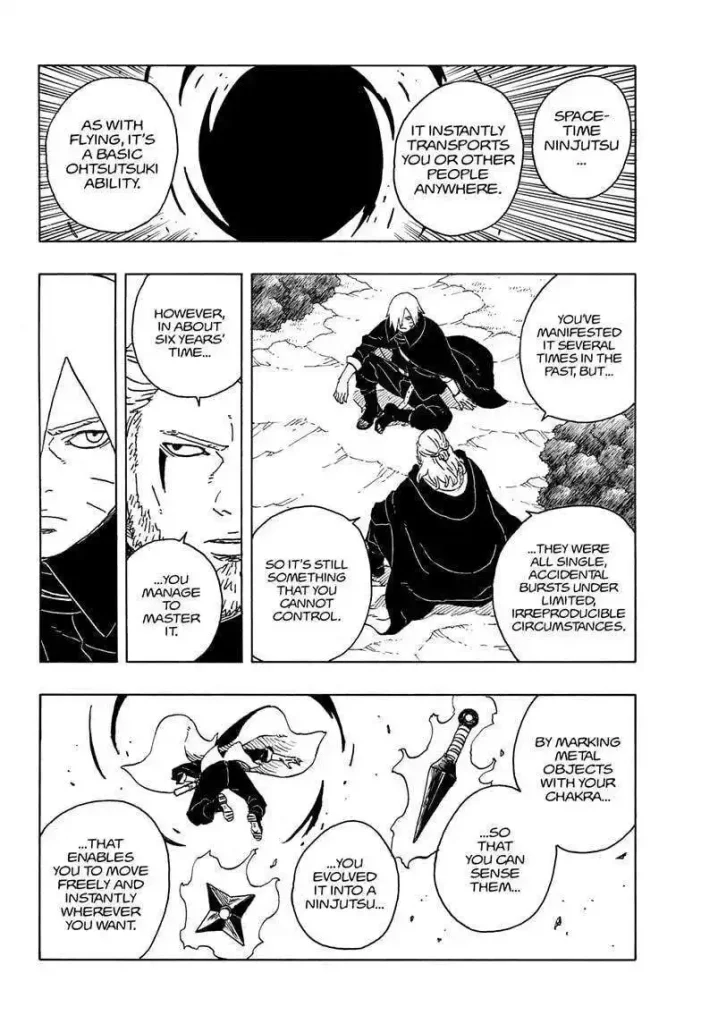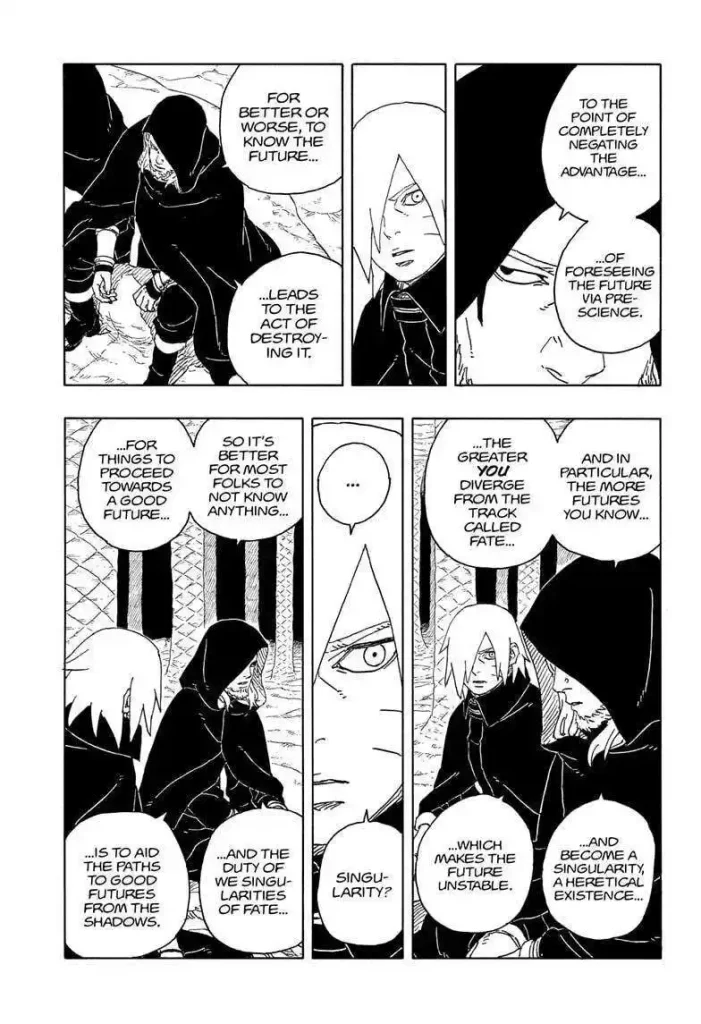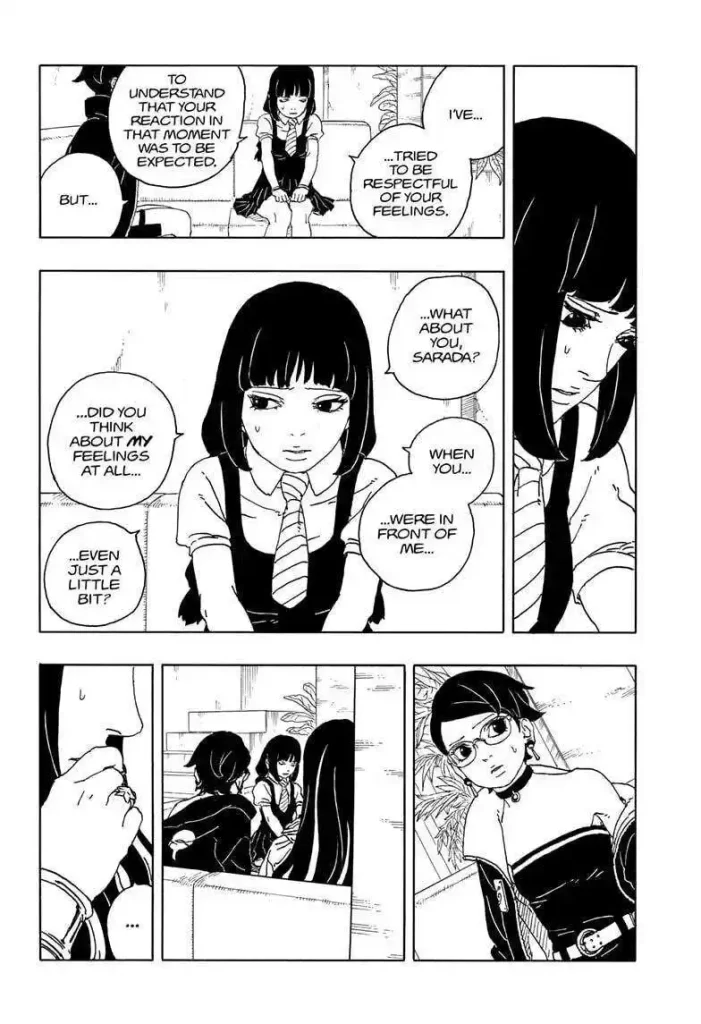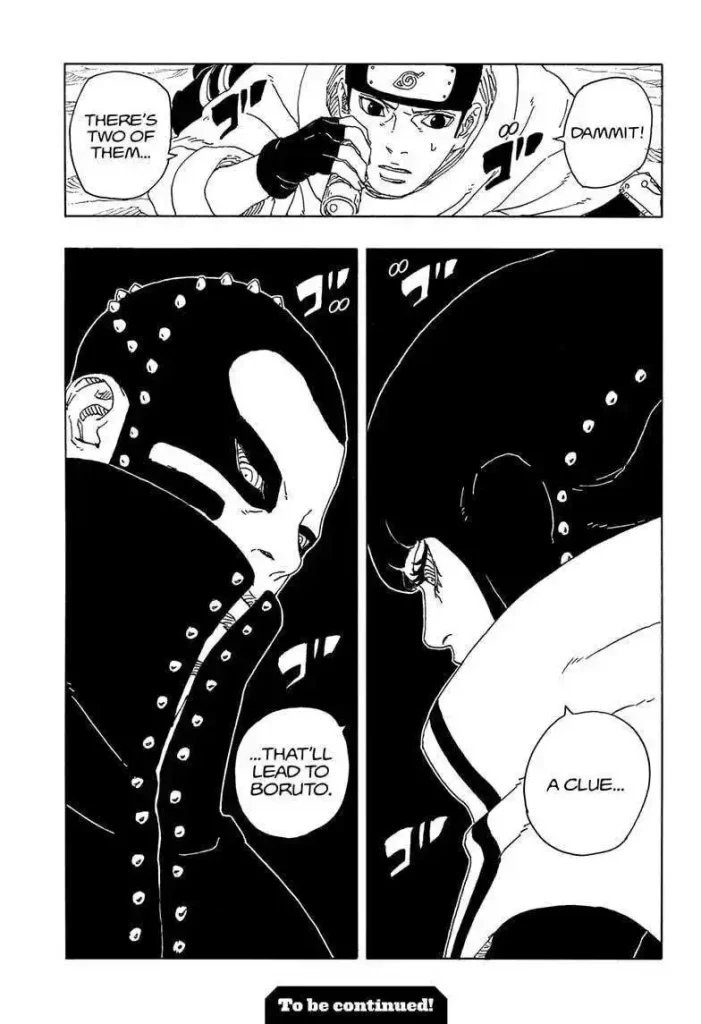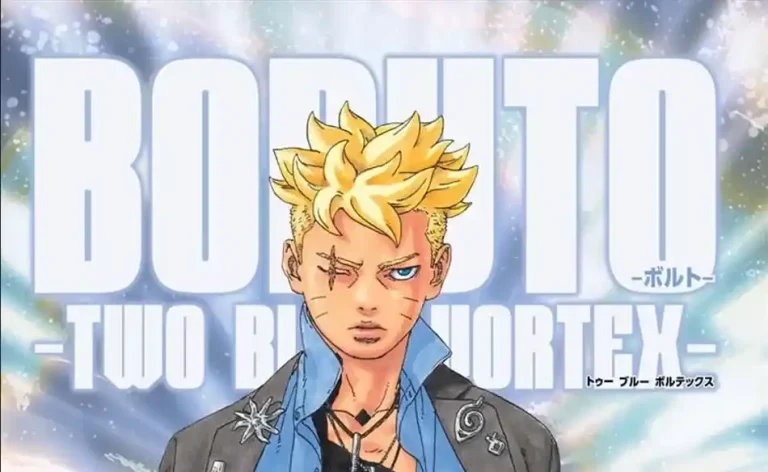Read Boruto Two Blue Vortex Manga, Chapter 16 (The Singularity of Fate) Online In High Quality For Free

Read: Boruto Manga Online
Boruto Two Blue Vortex Chapter 16 Review – Flying Thunder God, Sumire’s Confession & The Singularity of Fate
So, we finally have Chapter 16 of Boruto: Two Blue Vortex which reveals the backstory behind Boruto’s Flying Thunder God technique and how it functions. There’s also Sumire’s confession of love for Boruto, which causes tension between her and Sarada. Additionally, we see the Shinju showing up in the Sand Village to face off against Team Seven. There’s a lot to discuss, but we’ll start from the top.
The person on this month’s cover is Eida (Ada), and the chapter title is “Singularity of Fate,” which ties into something exciting that we’ll discuss later in the review.
The Evolution of Boruto’s Flying Thunder God Technique
The first panel shows a younger Boruto having a conversation with Kashin Koji. Koji explains to Boruto that Space-Time Ninjutsu can instantly transfer any object to any location, regardless of self or others. He compares it to the ability to fly, describing it as one of the elemental powers possessed by the Otsutsuki. I mentioned this in a spoiler article, and some readers needed clarification about what he referred to here. To clarify, he references the Space-Time Vortex that the Otsutsuki use to travel to different dimensions.
Boruto has used this ability on multiple occasions. The first time, Kawaki triggered it to send him to Jigen’s dimension to save Naruto. The second time, Kawaki again coerced Boruto into using it to escape Isshiki’s dimension. However, Boruto has never used this ability of his own accord, which is why Kashin Koji explains that it is not yet under his control.
Koji says, “But you, six years into the future, will succeed in controlling this power.” He elaborates that by assigning chakra to ninja tools and using sensory perception, Boruto can instantly travel to any location. This ability has been sublimated into a Ninjutsu, allowing unrestrained movement.
This part is particularly fascinating because it implies that the ability wasn’t a Ninjutsu before—it was a Shinjutsu ability of the Otsutsuki. This raises the question: are all innate Otsutsuki abilities, such as the Space-Time Vortex, flying, chakra suppression, or rod manipulation, Shinjuku? While this isn’t confirmed, it’s an interesting theory to consider.
Koji then confirms he is referring to the Flying Thunder God technique, which Boruto’s grandfather, Minato Namikaze, specialized in. However, he also points out that Boruto’s version is a different technique. Koji explains that, while searching for a method to control Space-Time Ninjutsu in the ninja world, Boruto accidentally created a variant of the Flying Thunder God technique. This implies that the Flying Thunder God technique might be an offshoot of the Space-Time Vortex, though they differ in mechanics: Flying Thunder God requires pre-made markings, whereas the vortex does not.
The manga then shows a panel of Boruto training to use this technique. He teleports to different shurikens, and Koji remarks that ninja tools are the most suitable medium for granting chakra. After much trial and error, Boruto arrives at this solution. Boruto asks if his katana could work, to which Koji replies that kunai, shuriken, or any ninja tool can serve as a medium for teleportation. Teleportation becomes more accurate and accessible if the medium is within visible range. This explains why it took Boruto so long to teleport to the Ten-Tails’ dimension in Chapter 4 of the Boruto manga.
Boruto supports this conclusion, noting that it’s challenging to teleport over long distances. Koji explains that if two identical mediums, such as shurikens, are located in the north and south, Boruto cannot decide which one he will teleport to. Boruto agrees, saying, “That might be difficult.” Koji replies, “If the medium is always only one, there’s no problem. But that also means you can’t fully utilize the convenience of this technique.”
Boruto then thinks of using objects with distinct shapes as mediums to represent different coordinates. This lets him teleport to the intended location, even over great distances. He concludes that using various shapes is critical to mastering this technique.
Koji adds that teleportation over long distances requires more concentration and is significantly more complicated. He tells Boruto that knowledge alone isn’t enough—mastery requires extraordinary training. Boruto, undeterred, says, “Don’t worry. Let’s keep going. We have to do it.”
Later that day, the scene shifts to Orochimaru’s hideout. Boruto says, “If both a good and bad future can be seen, it would be better to inform everyone and gain their cooperation. Of course, things would move more positively, right?”
Kashin Koji remarks, “It’s ironically frustrating, but the more people know, the more they understand, and the future changes dramatically.” He then elaborates by saying, “I knew it; therefore, I no longer behave as if I didn’t know. As a result, the future branches out complexly, making predictions exceedingly difficult. Under such circumstances, the very advantage of foreseeing the future here and everywhere becomes meaningless.”
He continues, “Listen, knowing the future—for better or worse—is nothing but an act of drawing the future. The more one knows about the future, the more that person deviates greatly from reality, which is destiny. Such a person becomes a heretical existence that destabilizes the future, a singularity. To advance, we must aim for the future. Everyone shouldn’t know the future. Our duty, as the singularity of destiny, is to support the journey toward a good future from behind the scenes.”
When Koji mentions “our duty,” Boruto asks, “Me too?” Koji responds, “You’re like me, already a singularity.”
This revelation shocks Boruto. Koji adds, “Sooner or later, you must meet or inform Eida.” At this point, it’s revealed that Eida is watching their conversation in real-time. This implies that Koji knew, even in the past, that Eida would be watching this specific moment and hearing his words at this exact second—a mind-blowing level of foresight.
While this is impressive, the best part of Chapter 16, which genuinely has my mind spinning, is the concept of the “Singularity of Fate.” A singularity is a pivotal moment or event where the typical flow of destiny is disrupted, altered, or concentrated. It is a point where all possible outcomes—what we often call prescience—converge into one inevitable event that could change someone’s life or the entire world’s fate.
This ties back to Boruto’s statement atop the Hokage Monument, where he asks whether a particular event was the only possible outcome. This implies that the event is a fixed point in time—a singularity.
Of course, this might seem contradictory, as Koji foresaw futures in which the Ten-Tails devoured Kawaki, yet none came to pass. However, it’s important to remember that singularities can be created at later points in time. Certain events must occur before all paths converge in that direction.
This means that Kashin Koji must ensure everything happens in a specific manner to guarantee all paths lead to Kawaki and Boruto fighting atop the Hokage Monument.
Koji also refers to singularities as individual entities, such as himself and Boruto, because they can influence and “draw” the future by knowing it. If Boruto were to share knowledge of the future with everyone, those individuals would also gain the ability to alter it. This would create a situation of “too many cooks in the kitchen,” making it impossible to dictate the course of events. This is why Koji advises Boruto to keep the future private.
Of course, Eida already knows about the future due to her Senrigan ability. However, it’s implied that Koji has a plan for Eida since he knows she will gain this knowledge. How this plays out remains to be seen.
The Tension Between Sarada and Sumire
Now, shifting to Sarada and Eida, Sarada asks Eida what she has discovered. Eida replies, “The reason Boruto doesn’t want to talk much is, I guess, because he has his reasons. After all, I think he deliberately tries to stay silent to prevent unnecessary harm from coming to you.”
Sarada responds, “That might be true, but Boruto carries it alone. It’s Konoha”—referring to the village—“and even though it’s clear we’re all dealing with a common enemy, he’s refusing to stop. At the very least, I want to help him.”*
She then asks, “Eida, where’s Boruto now?”
Before Eida can respond, Sumire interrupts. She hesitates but eventually says, “Maybe Boruto doesn’t want to be found. Maybe…” Sarada cuts her off, asking, “What?”
Sumire continues, “We openly support Boruto, but we don’t have much information about him. That’s why they shouldn’t be chasing him.”
Sarada jumps in, “But you saw it too, Sumire! He might have died if things went poorly. Going against the Shinju alone is just too reckless.”
Sumire counters, “Have you thought about Boruto’s feelings? Do you think he does this willingly? There are some things you want to talk about but can’t. Have you ever considered that?”
Sarada is taken aback, visibly shocked by Sumire’s words. Sumire, nervous and sweating, bows her head and says, “Not just Boruto, but my feelings too. You know that, right? I like Boruto, yet you were the first to jump in and say it.”
She clarifies, “Or maybe you were the first to hug him. Either way, it doesn’t matter.”
This line has been translated differently, and while one version implies Sumire means Sarada hugged Boruto before she could, it’s also possible that Sumire is just referring to Sarada openly expressing her feelings first. It’s worth noting that they’ve all known each other since childhood, so it might not necessarily imply romantic tension. However, they are teenagers, so expecting some emotional complexities is natural.
Sumire continues, “I understand how you feel in that situation. It’s not that you’ve turned out like that, but… what about me? Right before me, did you even care about my feelings, even a little?”
Sarada remains silent, stunned by Sumire’s outburst. The tension prompts Eida to remark, “The atmosphere is so bad internally. It’s way too awkward—I can’t move an inch! But at the same time, this situation is so tense, I can’t stop watching.”
Sumire then stands abruptly and says, “I’m sorry. Why is it like this? In this kind of situation, it shouldn’t be like this.” She runs away, and Sarada tries to stop her, shouting, “Wait, class rep!”
Sumire replies, “For how long will you keep calling me that? Class rep?” She then leaves.
This moment likely ties back to Boruto calling Sumire “class rep” in Chapter 6 of the manga. It could imply their relationship isn’t close enough to warrant using first names. However, this seems unlikely since even Sarada, who is good friends with Sumire, refers to her as a “class rep.” It’s more likely that they’re used to calling her this, a habit that has stayed the same despite their evolving relationships.
That said, these are teenagers—emotional and prone to overthinking. Misinterpretations are inevitable in such situations, which could be one of those moments. Still, I’m possibly wrong; there could be more profound reasons for this dynamic. Only time will tell.
We then skip to the Daimyo, conversing with the village elders. The Daimyo asks them, “What’s going on? He must have made contact several times already. Is it, honestly, letting someone escape after capturing them once? Even so, it’s just a rogue ninja or two. Why can’t they be dealt with?”
The elders reply, “Sincerely, there’s no excuse to justify this.”
The Daimyo responds, “Quickly catch him and put an end to his life. If you can’t do that, the appropriate person must take responsibility.”
One of the elders reassures him, “Please rest assured. I’ll act by your wishes. I will ensure this matter is resolved.”
This exchange implies that Shikamaru is in deep trouble. However, how they plan to resolve the situation must be clarified since they cannot handle Boruto. It raises questions about what they will do to Shikamaru. Will they demote him, imprison him, or punish him in some other way?
Despite their lack of actual combat ability, it’s remarkable how much power the Daimyo and elders wield. The Hidden Leaf Village is the most potent force on the planet, capable of handling anyone who opposes them. However, the village still requires funding to operate, maintain a stable economy, and sustain trade relations. They can’t rely solely on their strength—they need diplomacy to build relationships with the lords. They must comply with established laws and expectations to avoid becoming a dictatorship.
If Daimyo demands Shikamaru to step down, he may have to comply. This scenario may plant the seeds for Kawaki’s eventual disdain for the Shinobi system, where lords and politics overstep their boundaries. It’s unclear what could push Kawaki down that path, but this might be the beginning of it.
We then shift to Shikamaru, meeting Eida on a balcony. He says, “As for me, I’d rather avoid meeting and talking face to face. My mind slows down when I look at you.”
Eida teases, “Well, you don’t want to be heard by the sensory team, but it’s cute when you’re out of sorts like that. I like it.”
Shikamaru continues, “So, what’s the situation in the Sand?”
Eida replies, “Unfortunately, as you expected, a new Shinju is being born. His name is Ryu, and his origin lies with a child from the Sand.”
Shikamaru asks, “Shinki?”
Eida confirms, “Yes. His target is the Kazekage. For now, he’s sealed and safe, but Ryu can undo the seal, probably because it’s his technique.”
Shikamaru responds, “If we don’t take him down, Gaara will be in trouble. I’ll arrange a mission to the Sand immediately.”
Eida adds, “By the way, I saw footage a few hours ago. There are some troublesome ones among them. One of them was able to see me when I used the Senrigan. He was peering at me.”
She continues, “My blood ran cold when it happened, so forgive me for not wanting to watch them in real time. I feel so bad.”
Shikamaru reassures her, “Got it. You don’t have to push yourself. I don’t mind if it’s a log from the past.”
Eida then says, “This is about Boruto. You stopped trying to kill him, didn’t you? You used Mitsuki to let him get away.”
Shikamaru tries to deny it, but Eida calls him out, “Feigning ignorance, I see. Don’t worry; I won’t snitch to the rest of the village. It would be inconvenient for me if your position were compromised. More than anything, I don’t want to cause trouble for Boruto.”
Shikamaru gives her a look, and she quickly adds, “Don’t mind me. I’m just talking to myself.”
She continues, “Kawaki has agreed to cooperate with Boruto for now. At the very least, if you want to do something about the Shinju, it’s better if you don’t get in their way.”
Shikamaru asks, “Eida, Boruto has a secret collaborator. Did you see him last time he talked to me? He appeared in the form of a toad. I remember seeing that frog somewhere before—it’s Kashin Koji, right?”
At that moment, one of Koji’s toads emerges from Eida’s clothing and says, “Good guess, Shikamaru. It’s just as you say. I’ll only tell you the gist of it. No questions, understand?”
Koji continues, “Dispatch only Konohamaru, Sarada, and Mitsuki to the Land of Wind. Ryu—or maybe Matsuri—will show up there. It could be both, but your team will work with two shinobi from the Sand. Don’t let Uzumaki Himawari leave the village. She’s been targeted by Jura. If she leaves, she’ll run into him, and if that happens, she’ll die.”
Koji explains, “Jura has judged Konoha’s culture highly valued, so he’s reluctant to fight in the village. As long as Nothing catastrophic happens, Konoha will be safe. If Jura visits a bookstore, they should treat him like their number-one customer.”
Shikamaru asks, “Are you serious?”
Koji replies, “This guy isn’t a joke. If Jura gets serious, our chances of winning wouldn’t even be one million. Don’t intervene with Jura. We’ll take out his allies with the smallest force possible. If Jura shows up, flee immediately. That’s all for me. Good luck.”
Koji adds, “About your help with Boruto’s escape—although belatedly, I’m grateful. Despite no guarantees, you went against the rules and your fellow citizens to follow your heart for the sake of what you believe is right. I won’t force you to do anything. For the sake of the future, continue to follow your heart.”
With that, the toad disappears.
Shikamaru then says, “What a pain,” and smokes. We then get a panel of Eida thinking about what Koji said regarding following your heart. This could lead to Eida falling for Boruto instead of Kawaki, which might signify her finding her path. We’ll see how that plays out.
We also get two panels of Sumire looking sad, which is heartbreaking because seeing Sumire sad makes me sad—so everything feels sad.
Team Seven’s Mission in the Land of Wind
The scene then shifts to Sarada, Mitsuki, and Konohamaru entering the Land of Wind, where the Sand Village is located. Mitsuki asks Sarada, “What’s wrong?” She replies, “Nothing to worry about. It’s all right, I’m fine.”
It seems she’s still troubled by her earlier conversation with Sumire. Someone on Twitter had speculated about this, and it appears they were right. Sarada is worried about Sumire.
Konohamaru then says, “Don’t just zone out. We’ll be a laughingstock for the Sand Shinobi.”
I highly doubt that would be the case because those ninjas are Nothing compared to Sarada and her team—but that’s just my opinion.
Two Sand Shinobi then approach and greet them, saying, “Thank you for coming to the Land of Wind. We’re counting on your support.”
These two ninjas are Yodo and Araya, members of Team Shinki. Konohamaru responds, “The feeling is mutual. Let’s get going.”
We then get a panel where someone says, “The coordinates we heard about should be in that area with the column-shaped rocks.”
Mitsuki asks, “Sensei, where did you hear this information?”
Konohamaru replies, “I’m not sure. It sounded plausible, but honestly, I’m half in doubt.”
Yodo walks up to Sarada, saying, “Long time no see. Your vibe has changed a bit—taking a liking to a guy?”
Sarada, caught off guard, stammers, “That’s not—” but before she can finish, Yodo cuts in, “I see. Doesn’t matter much to me, but—”
Before Yodo can finish her sentence, Konohamaru interrupts, “There they are—the Shinju!”
We see Matsuri and Shinki’s Shinju standing between the columns, staring at a dead frog. Matsuri says, “It’s a clue connecting us to Boruto.”
This is where Chapter 16 of Boruto: Two Blue Vortex ends.
We’re setting up for an epic fight: Sage Mode Mitsuki versus Shinki, which will undoubtedly be glorious. It’s going to be amazing. Of course, Konohamaru will likely fight Matsuri.
Now, I will make a bold prediction, and I know some people might disagree. By the end of this fight, we’ll all agree that Konohamaru is now stronger than Gaara.
I know this might sound wild to some, but based on his feats in Two Blue Vortex and the fact that his opponent is Matsuri—the same person who destroyed Gaara—this could imply that he somewhat scales above Gaara to match up with Matsuri.
I could be wrong, and that’s fine—but we’ll see.
Let me know your thoughts about the chapter itself below. Did you think it was a good chapter? A bad one? Or perhaps a chapter that lacked substance?
I thought it was awesome. It was engaging, fun, and packed with potential for exciting developments.
Koji’s loyalty questioned, Shikamaru’s controversial strategy, and Team 7’s risky moves. Will it lead to disaster? Dive in Boruto two Blue Vortex chapter 17 wild beast cubs.


